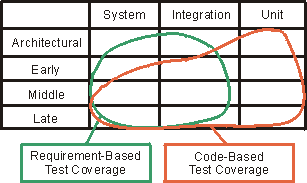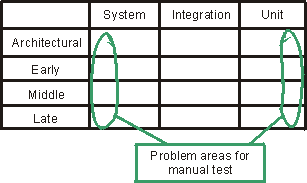Concepts: Test Strategy
A strategy for the testing portion of a project describes the general approach and objectives of the test activities. It includes which stages of testing (unit, integration and system) are to be addressed and which kinds of testing (function, performance, load, stress, etc.) are to be performed.
The strategy defines:
- Testing techniques and tools to be employed.
- What test completion and success criteria are to be used. For example, the criteria might allow the software to progress to acceptance testing when 95 percent of the test cases have been successfully executed. Another criterion is code coverage. This criterion may, in a safety-critical system, be that 100% of the code should be covered by tests.
- Special considerations affect resource requirements or have schedule implications such as:
- The testing of interfaces to external systems.
- Simulating physical damage or security threat.
Some organizations have corporate test strategies defined. In which case, you work to apply those strategies to your specific project.
The most important dimensions you should plan your test activities around are:
- What iteration you are you in, and what the goals of that iteration are.
- What stage of test (unit test, integration test, system test) you are performing. You may work all stages of test in one iteration.
Now take a look at how the characteristics of your test activities can change depending on where you are in the above-mentioned "test dimensions". There are of course many characteristics you could look at, such as resources needed and time spent, but at this point, focus on what is important to defining your test strategy:
- Types of test (functional, stress, volume, performance, usability, distribution, and so on).
- Evaluation criteria used (code-based test coverage, requirements-based test coverage, number of defects, mean time between failure, and so on.)
- Testing techniques used (manual and automated)
There is no general pattern for how the types of tests are distributed over the test cycles. Depending on the number of iterations, the size of the iteration, and what kind of project this is, you will focus on different types of tests.
You will find that the system test stage has a strong focus on making sure you are covering all testable requirements expressed in terms of a set of test cases. This means your completion criteria will focus on requirements-based test coverage. In the integration and unit test stages, you will find code-based test coverage is a more appropriate completion criterion. The following figure shows how the use of these two types of test coverage measures can change as you develop new iterations of your software.
- The test plan should define sets of completion criteria for unit test, integration test and system test.
- You may have different sets of completion criteria defined for individual iterations.

In your project you should consider automating your tests as much as possible, specifically the kind of tests you repeat several times (regression tests). But keep in mind that it costs time and resources to create and maintain automated tests. There will always be some amount of manual testing in each project. The following figure illustrates when and in what stages of testing you will probably perform manual tests.

Example:
The following tables show when the different types of tests are identified, and provide an example of the completion criteria to define. The first table shows a "typical" MIS project:
| Iteration / test | System test | Integration test | Unit test |
| Iteration 1 | Automated performance testing for all use cases. · All planned tests have been executed. · All severity 1 defects have been addressed. All planned tests have been re-executed and no new severity 1 defects identified. |
None | Informal testing |
| Iteration 2 | Automated performance and functionality testing for
all new use cases and the previous as regression test. · All planned tests have been executed. · All severity 1 and 2 defects have been addressed. · All planned tests have been re-executed and no new severity 1 or 2 defects identified. |
None | Informal testing |
| Iteration 3 | Automated functionality and negative testing for
all new use cases and all the previous as regression test. 95% of test cases have to pass. · All planned tests have been executed. · All severity 1, 2, and 3 defects identified. |
Automated testing, 70% code coverage. | Informal testing |
| Iteration 4 | Automated functionality and negative testing for
all use cases, manual testing for all parts that are not automated and all the previous as
regression test. 100% of test cases have to pass. · All planned tests have been executed. · All severity 1, 2, and 3 defects have been addressed. · All planned tests have been re-executed and no new severity 1 or 2 defects identified. |
Automated testing, 80% code coverage. | Informal testing |
The second table shows types of test and completion criteria applied for a "typical" safety-critical system:
| Iteration / test | System test | Integration test | Unit test |
| Iteration 1 | Automated performance testing for all use cases,
100% test-case coverage. · All planned tests have been executed. · All severity 1 defects have been addressed. · All planned tests have bee re-executed and no new defects identified. |
None | None |
| Iteration 2 | Automated performance, functionality and negative
testing for all use cases, 100% test-case coverage. · All planned tests have been executed. · All severity 1 or 2 defects have been addressed. · All planned tests have been re-executed and no new defects identified. |
Automated performance testing | Informal testing |
| Iteration 3 | Automated performance, functionality, negative
usability and documentation testing for all use cases, 100% test-case coverage. · All planned tests have been executed. · All severity 1, 2, and 3 defects have been addressed. · All planned tests have been re-executed and no new defects identified. |
Automated performance testing and the previous as regression test | Automated testing, 70% code coverage |
| Iteration 4 | Automated performance, functionality, negative
usability and documentation testing for all use cases, 100% test-case coverage. · All planned tests have been executed. · All severity 1, 2, and 3 defects have been addressed. · All planned tests have been re-executed and no defects identified. |
Automated performance testing and the previous as regression testing | Automated testing, 80% code coverage |
![]()